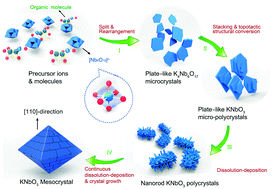Structural and morphological evolution of an octahedral KNbO3 mesocrystal via self-assembly-topotactic conversion process†
Abstract
Different morphologies of potassium niobates were prepared via a novel two-step solvothermal process. Firstly, a precursor polyion solution of [Nb6O19]8− was prepared. Secondly, the different morphologies of potassium niobates were prepared by solvothermal treatment of the polyion solution in different water–organic solvents and adjusting the composition of the solvents. A meaningful KNbO3 (KN) mesocrystal with octahedral morphology was generated for the first time using propylamine as the solvent. The as-obtained KN mesocrystal was a polycrystal constructed from uniform [110]-crystal-axis-oriented KN nanocube crystals, which show a set of single-crystal-like electron diffraction spots. The KN mesocrystal was formed via a self-assembly-topotactic conversion mechanism including the self-assembly of plate-like particles, topotactic conversion to the KN structure and mesocrystalline crystal growth of KN nanocrystals. Such mesocrystal displays a higher piezoelectric response than common individual perovskite crystals. The success in developing the KN mesocrystal can be easily applied to the preparation of a series of piezoelectric K1−xNaxNbO3 continuous solid solution mesocrystals.



 Please wait while we load your content...
Please wait while we load your content...